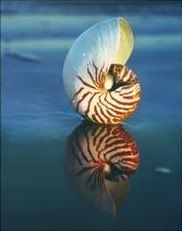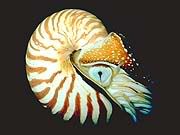I Just Love The Nautilus

"The history of life can be great theater. . . . The development of the gas-and liquid-filled chamber in the shell liberated the nautiloids from the sea bottom and set in motion an evolutionary history that is still unfolding today."
~ Peter Ward, Paleontologist ~
Facts:
A native of the tropical Pacific, this cousin of the octopus is a living link with the past—little changed for more than 500 million years. Its simple eyes may see no more than the difference between dark and light, but the nautilus uses its more than 90 tentacles to touch and taste the world. A nautilus’s tentacles—unlike those of other cephlapods (octopus, squid, cuttlefish)—have grooves and ridges that grip food and pass it into the nautilus’s mouth. A parrotlike beak rips the food apart, and a radula (found in most molluscs) further shreds the food.
To avoid predators by day, a nautilus lingers along deep reef slopes, some as deep as 2,000 feet (610 m). At night, a nautilus migrates to shallower waters and cruises the reefs, trailing its tentacles in search of food.
A nautilus swims using jet propulsion—it expels water from its mantle cavity through a siphon located near its head. By adjusting the direction of the siphon, a nautilus can swim forward, backward or sideways.
Nautilus populations tend to be 75% males and 25% females. Reasons for this are not yet clear.

Fossils of the nautilus, a cephalopod mollusc, dating back 400 million years have been discovered in Xinglong County, in north China's Hebei province. According to experts, the nautilus fossils discovered in the Yanshan mountain range in north China were small molluscs which inhabited the ocean floor about 400 million years ago. The mollusc had gills and was covered with a spiral shell. The nautilus fossils were found in a limestone surface near a limestone cave in the highest peak of Yanshan Mountain. Experts noted that the discovery is extremely valuable to the study of the evolution of geology, topography and biology and has aroused the attention of archaeologists from Britain, the United States and Japan.
I've always loved this little creature. When I first saw one, I saw only the shell, on display, and it truly is a remarkable example of nature. I thought it must contain a slug-like thing or a hermit crab. And when I found out that there is so much more to it, I fell in love. Look at that eye - how looks deceive, it's little more than a pinhole with no lens. And to think that it "touches and tastes the world" with all those tentacles. Gaze at the beauty of the shell - a true gift of nature. Perhaps that's why it keeps such a hold on that shell, when other branches of the species dropped theirs so long ago?
I do seem to be stuck on the subject of shells right now.
Facts:
A native of the tropical Pacific, this cousin of the octopus is a living link with the past—little changed for more than 500 million years. Its simple eyes may see no more than the difference between dark and light, but the nautilus uses its more than 90 tentacles to touch and taste the world. A nautilus’s tentacles—unlike those of other cephlapods (octopus, squid, cuttlefish)—have grooves and ridges that grip food and pass it into the nautilus’s mouth. A parrotlike beak rips the food apart, and a radula (found in most molluscs) further shreds the food.
To avoid predators by day, a nautilus lingers along deep reef slopes, some as deep as 2,000 feet (610 m). At night, a nautilus migrates to shallower waters and cruises the reefs, trailing its tentacles in search of food.
A nautilus swims using jet propulsion—it expels water from its mantle cavity through a siphon located near its head. By adjusting the direction of the siphon, a nautilus can swim forward, backward or sideways.
Nautilus populations tend to be 75% males and 25% females. Reasons for this are not yet clear.

Fossils of the nautilus, a cephalopod mollusc, dating back 400 million years have been discovered in Xinglong County, in north China's Hebei province. According to experts, the nautilus fossils discovered in the Yanshan mountain range in north China were small molluscs which inhabited the ocean floor about 400 million years ago. The mollusc had gills and was covered with a spiral shell. The nautilus fossils were found in a limestone surface near a limestone cave in the highest peak of Yanshan Mountain. Experts noted that the discovery is extremely valuable to the study of the evolution of geology, topography and biology and has aroused the attention of archaeologists from Britain, the United States and Japan.
I've always loved this little creature. When I first saw one, I saw only the shell, on display, and it truly is a remarkable example of nature. I thought it must contain a slug-like thing or a hermit crab. And when I found out that there is so much more to it, I fell in love. Look at that eye - how looks deceive, it's little more than a pinhole with no lens. And to think that it "touches and tastes the world" with all those tentacles. Gaze at the beauty of the shell - a true gift of nature. Perhaps that's why it keeps such a hold on that shell, when other branches of the species dropped theirs so long ago?
I do seem to be stuck on the subject of shells right now.




5 comments:
It truly does some seem like a fascinating creature, in addition to being beautiful.....when one reads more than just the facts of the animal..one can in a sense 'see' some similarities in the way some of us deal with our world...love this post...thanks :-)
~Sunny D~
Next post, I promise will not be about shells!!
No promises though, for the one after that :)
lol..i like shells, in fact i love shells...not sure i have completely left mine behind yet!
I do too!!! Am very conflicted over their beauty in the form I can keep vs. their beauty in the form they are when alive.
Missy you should be in bed...tapping my watch *L*
BUSTYGURLZRULE!!!
OMG my verification word is.....
HOIAM
LMAO!!!!!
LMFAO!!!! Now we are getting messages through word verification!
And I am going to pay today for not sleeping last night.....but mmmmmm I had a very much needed cuddle instead :)
And yes indeedy BUSTYGURLZRULE!!!
Post a Comment